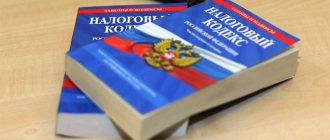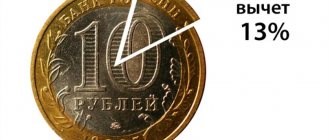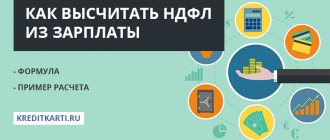The right to a tax deduction appears in the case when you have carried out certain transactions with property (Article 220 of the Tax Code of the Russian Federation). It could be:
- buying a home - a house, apartment, room, etc.;
- sale of property;
- construction of housing or acquisition of land for these purposes.
To receive a tax deduction, you will need either a registration certificate and a purchase and sale agreement, or a transfer and acceptance certificate and a share participation agreement.
In this article we will look at the situation with purchasing an apartment.
- Who can receive a property tax deduction
- What documents are needed to receive a deduction?
- Amount of deduction and maximum expenses
- How to calculate the amount of deduction
- What is taken into account as expenses when calculating deductions
- Stages of obtaining a property tax deduction
- Obtaining a property tax deduction through an employer
- In 2021, it will be possible to receive a tax deduction without a declaration
All about standard tax deductions
In my last publication, I wrote about who is entitled to tax deductions . I would like to continue the series of articles on this topic.
5 types of tax deductions in the Tax Code (TC) of the Russian Federation Today I will talk about one of these types.
My post today will be about standard tax deductions .
Deduction for pension contribution - 15,600 rubles
If you decide that you shouldn’t count on a state pension, then this item is for you. By opening a deposit in a non-state pension fund, you will be able to return the same 13% of the contribution amount every year. This means that another 13% per annum will be added to the return on your pension contribution (about 6%). And this is already super profitability! Even successful investments rarely bring in that much.
And most importantly, these savings are absolutely, completely, 100% insured. Even the bailiffs do not have the right to seize them. Well, if something happens to you, your relatives or the persons specified in the contract will inherit the savings.
Standard tax deductions
The procedure for calculating and paying standard tax deductions for personal income tax is regulated by Article 218 of the Tax Code of the Russian Federation. In order to begin receiving standard tax deductions, you must meet certain requirements and also collect a set of documents. Nothing complicated. Below I will describe what requirements apply to those wishing to receive standard tax deductions, and a list of documents required to submit to the Tax Service or employer.
Standard tax deductions include:
1) tax deduction for child (children);
2) tax deduction for the taxpayer.
Since 2021, a new reporting form has been introduced in Russia - ESSS
Since January 1, 2021, a new reporting system has been in effect in the Russian Federation - the Unified Social Insurance Fee (USSS), which actually combines mandatory payments to social funds (FSS, PFR, FFOMS). This measure was introduced on the basis of a decree, according to which control over social contributions from this year was entrusted to the Federal Tax Service.
Important! Submission of unified reporting on ESSC contributions to the tax service is a mandatory condition for taxpayers and policyholders.
Payment under the ESSS must be made monthly on the 15th of the following month. The amount required for payment is clearly indicated in rubles and kopecks, without rounding. Contributions are calculated based on the total monthly indicators from the beginning of the billing period to the end of the calendar month (benefits and contributions paid in the current year are not taken into account)
The ESSS report is submitted on one day; if the deadline for submission falls on a weekend or holiday, the report is submitted on the first working day after the weekend. The report can be submitted electronically or in paper form (allowed if the organization's staff includes no more than 25 employees).
The ESSS tax report is submitted every quarter to the Federal Tax Service at the place of registration of the organization. Separate divisions of the enterprise report at their location, and they must independently pay salaries to their employees, have a separate balance sheet and current account.
Starting from January 1, 2021, tax services and the Pension Fund of Russia conduct on-site and desk audits of payer lists and settlement reconciliations. The verification period is 3 years.
Tax deduction for child(ren)
In order to start receiving tax deductions for a child, you need to meet simple criteria. The criteria are generally simple.
• presence of at least one child in the family;
• the parent works under an employment contract and is a tax resident of the Russian Federation;
• monthly pays personal income tax (NDFL) to the country's budget.
EACH can submit a set of documents to receive a deduction for a child if both work under an employment contract and pay taxes to the state.
You can receive a tax deduction for a child (children):
from the birth (adoption, guardianship) of a child until he reaches 18 years of age ;
or up to 24 years of age , provided that the child is a full-time student, graduate student, resident, intern, student under 24 years of age, or disabled group I or II.
RUB 1,400/month - for the first and second child;
RUB 3,000/month - for the third and each subsequent child
6,000 rubles/month – if the parents are adoptive or have formalized guardianship and 12,000 rubles/month. parents. These amounts of tax deductions can be counted on if the child is disabled, not older than 18 years , or a child is a full-time student, graduate student, resident, intern, student under 24 years of age, or a disabled person of group I or II.
Attention! to receive the amounts indicated above . This is the part of the money on which you will not be charged 13% personal income tax. To receive a tax deduction for a child (children), provide the employer with a set of documents, after which the employer will report to the tax office on your behalf.
A deduction for a child can be received up to the month in which the taxpayer’s income, taxed at a rate of 13% and calculated on an accrual basis from the beginning of the year, exceeded 350,000 rubles. The deduction will be canceled from that month if the taxpayer's income exceeds this amount. And from January next year, payments will continue.
In simpler terms, as soon as you earn 350,000 rubles from the beginning of the calendar year, then after that you will not be able to count on a tax deduction. But starting from January of the new calendar year, everything will start all over again, you will again be able to claim tax deductions, but again until your income in the form of wages reaches 350,000 rubles.
The standard tax deduction can be combined with other types of tax deductions.
If a married couple, in addition to a common child, has children from previous marriages, the common child is considered the third. This means the deduction for it will be 3,000 rubles.
To correctly calculate the amount of the tax deduction, you need to take into account all children, even those whose age exceeded the age up to which the deduction is calculated. Let's say the Shevchenko family, Dmitry and Ekaterina, have two children aged 11 and 14 years.
Catherine has a son from her first marriage, who is 25 years old. This age does not allow you to receive tax deductions, since they are only available until you reach 24 years of age.
Thus, the tax deduction will be calculated as follows. Dmitry Shevchenko - 2,800 rubles. (RUR 1,400 + RUR 1,400 for the first and second child). And Ekaterina Shevchenko - 4,400 rubles. (RUR 1,400 + RUR 3,000 for the second and third child; for the first child, who is 25 years old, it is no longer possible to receive a tax deduction).
To receive a tax deduction for children (children), ALL children born or taken (adopted) into a family for upbringing are taken into account.
If a citizen did not get a job from the beginning of the year, then when calculating tax deductions, his income from previous places of work during the reporting period (year) is taken into account. To do this, you need to take personal income tax certificate 2 from your previous places of work, which will indicate the total amount of earnings and the amount of deductions provided.
If the taxpayer has not used his right to tax deductions, then he can submit a declaration to the Federal Tax Service calculating the amount of income. The declared amount of deductions will be reimbursed by the tax authority after verification of documents.
Essentially, you can file for tax deductions after the fact. Starting from the beginning of the next year (reporting period), you submit a set of documents to the Federal Tax Service. Actually, you'll have to do it yourself.
For those citizens whose child is outside the Russian Federation, a tax deduction is provided on the basis of documents certified by the competent authorities of the state in which the child (children) live.
Refund of personal income tax on mortgage
For a mortgage, the personal income tax refund is 13% of all interest paid to the bank for 12 months. The decision on reimbursement is made by the Tax Inspectorate based on the documents provided by the borrower. The list of documents, in addition to the declaration, includes:
- a copy of the borrower's main document;
- certificate from place of work;
- a copy of the loan obligation;
- document confirming payment of interest for 12 months.
A personal income tax refund is a taxpayer’s right guaranteed by the state to receive part of the amount of money when purchasing real estate.
back to menu ↑
How to return the 13 percent tax / Income tax refund when buying an apartment
Double tax deduction
In certain cases, a tax deduction for a child (children) may be provided in double amount. This happens in cases where the parent is recognized as the only parent (guardian, adoptive parent). This can happen in the event of death, unknown absence, or when the second parent writes an application to refuse to receive a tax deduction for the child (children).
If this single parent gets married, then it will be impossible to hope for a tax deduction from the next month , after the month in which the marriage took place.
Divorced parents cannot claim double tax deductions
How often can I use the benefit?
The current tax legislation in Russia limits its citizens' ability to use benefits multiple times. Thus, you can apply for a property deduction once (one-time, regardless of the cost, if the housing was purchased before 2014) and several times (if the housing was purchased after the specified date), but the total amount in this case will not exceed 260 thousand rubles.
Examples of calculating the amount of tax deduction for a child (children)
The amount of the tax deduction depends on the number of children in the family and the salary of each parent. Based on these two factors, your employer’s accounting department will calculate the amount of your tax deduction.
Let me give you example No. 1
Andrey Andreev and Marina Andreeva work under an employment contract, both pay taxes to the state.
Their family has 3 children - 4, 7, and 12 years old. The Andreevs have the right to take advantage of the child tax deduction.
Ivan’s salary is small, 25,000 rubles/month. Marina’s salary is 20,000 rubles. /month
Every month, Andrey and Marina deduct 13% personal income tax (NDFL) from their salaries.
25,000 rub. * 13% tax = 3,250 rub. In total, Ivan’s “net” salary is 21,750 rubles.
20,000 rub. * 13% tax = 2,600 rub. In total, Marina’s “net” salary is 17,400 rubles.
For the first two children EACH
from parents can count on a deduction of 1,400 rubles.
+ 1,400 rubles, and for the third child - 3,000 rubles. This means that the total amount with which you can return the 13% tax deduction is 5,800 rubles/month.
5,800 rubles * 13% = 754 rubles/month . There are two parents, so we multiply 754 rubles. * 2 = 1,508 rubles/month.
This is exactly the amount the Andreev family has the right to count on in the form of a monthly tax refund.
This means that Ivan’s salary will increase slightly - 21,750 rubles. + 754 rub. = 22,504 rubles/month.
Marina’s earnings will be 17,600 rubles. + 754 rub. = 18,354 rubles/month.
As you can see, the earnings of both parents per year do not exceed 350,000 rubles. (25,000 rubles *12 months = 300,000 rubles - Ivan,
and 20,000 rub. * 12 months = 240,000 rub. - Marina), so their monthly salary, thanks to tax deductions, will be a little more.
It turns out that in a year, the Andreev family will return 1,508 rubles per month for 3 children. * 12 months = 18,096 rub.
Not a bad result, isn't it?
Accordingly, those people whose annual earnings are over 350 thousand rubles will be able to receive a tax deduction until the month when their income exceeds the amount of 350 thousand rubles.
Let me give you example No. 2
Pyotr Panchenko and Victoria Panchenko, working under an employment contract, conscientiously pay taxes to the state on their income. There is 1 child in their family. The Panchenko family has the right to receive a tax deduction for this child.
Peter's salary is 50,000 rubles/month. , Victoria's salary is 40,000 rubles. /month
50,000 rub. *13% tax = 6,500 rub. Thus, Peter’s “net” salary after paying 13% personal income tax will be 43,500 rubles.
40,000 rub. *13% tax = 5,200 rub. In total, Victoria’s “net” salary will be 34,800 rubles.
Each parent has the right to receive a tax deduction of 1,400 rubles per month for their only child.
1,400 rub./month *13% = 182 rub./month. — the amount of tax deduction per month for 1 child.
We remember that as soon as the amount of income exceeds RUR 350,000. It will be impossible to receive a tax deduction until the end of the year.
Peter's salary is 50,000 rubles/month. This means the amount of income is 350,000 rubles. it will exceed after 7 months.
That is, in the month of July his income will be 50,000 rubles/month * 7 months. = 350,000 rub.
And starting from August, he will no longer be able to count on a child tax deduction.
RUB 182/month tax deduction for an only child * 7 months = 1,274 rubles. - the amount that Peter can return with the help of a tax deduction in 7 months.
Victoria's salary is 40,000 rubles/month. Her income is 40,000 rubles/month * 9 months. = 360,000 rub.
It turns out that in September Victoria will exceed 350,000 rubles. and starting from October it will be impossible for her to receive a tax deduction.
That means 182 rubles/month. *9 months = 1,638 rub. - the amount that Victoria can return with the help of a tax deduction in 9 months.
The total amount of tax deduction that the Panchenko family will return during the calendar year is 1,274 rubles. + 1,638 rub. = 2,912 rub.
Amount of deduction and maximum expenses
There are some nuances with the registration of deductions depending on the type of property.
- Sole proprietorship . When buying an apartment, you can return the property tax deduction, but not more than 2 million rubles. 13% of the cost is refundable. By purchasing an apartment for 2 million rubles, you can return 260,000 rubles. previously paid taxes, and for 1 million rubles. — 130,000 rub. If the purchase price is more expensive, the refund amount will not change.
- Common shared ownership . For example, when purchasing ½ share in an apartment for 3 million rubles. You can apply for a deduction of no more than 1.5 million rubles.
- Common joint property . Until 2014, spouses for two could receive a deduction of no more than 2 million rubles. Therefore, it was more profitable to issue a deduction for only one of the spouses, and the other could receive another tax deduction in the future. Since 2014, the limit is 2 million rubles. are established not per property, but per person. For example, if the cost of an apartment is 5 million rubles, then each spouse can receive a deduction of 2 million. If the apartment costs 3 million rubles, you can agree to make a deduction of 1.5 million rubles, and then each 500,000 rubles remain, which can be used for the following objects.
List of documents required to obtain a tax deduction for a child
The convenience of filing a tax deduction for a child (children) is also the fact that you do not need to personally take the package of documents to the tax office. Collect the following set of documents to submit to your employer:
• an application for a standard tax deduction for a child (children) in the name of the employer;
• copies of documents confirming the right to receive a tax deduction for a child (children)
Important subtleties...
If the parent is the only one (the only adoptive parent), you need to add to the standard package of papers a photocopy of a document confirming that the parent is the only one.
For guardians (trustees), you need to add a copy of the document on guardianship or trusteeship of the child to the set of documents
When you have collected a set of documents, give it to your employer along with an application for a tax deduction for a child (children).
For those who want to understand how much tax deduction you can expect, indicate in the application all children by their dates of birth, by age, regardless of whether a deduction will be provided for the oldest child.
For those who work several jobs, you can submit a set of documents for a tax deduction of your choice exclusively to one employer.
How to get a deduction if a citizen works two jobs?
If before 2014 a citizen worked two jobs, then he could receive a deduction only at one place of work at his own request.
But after 2014, changes were made to the law. According to them, the legislator allowed citizens to receive property deductions from several managers at the same time.
The claim for deduction specifies how the employee distributes the refund among his or her supervisors. Based on this application, the tax authority issues a notice to employers with the specified amounts.
back to menu ↑
Example of an application for a tax deduction for a child(ren)
To the director of Zvezda LLC
(insert your company name)
from Vasily Fedorovich Vasechkin
(your full name)
residing at the address: Moscow,
Koroleva street, 7, apt. 79
Application for a tax deduction for a child (children)
In accordance with subparagraphs 2 and 4 of paragraph 1 of Article 218 of the Tax Code of the Russian Federation, I ask you to provide me with a standard tax deduction for personal income tax for my children:
Alexey Vasilievich Vasechkin born December 1, 2008
Vasechkina Daria Vasilievna born March 25, 2011
I am attaching to the application the following documents confirming the right to receive a tax deduction:
1._________________________________________________________________________________;
2._________________________________________________________________________________
Date__________ Signature____________/Vasechkin V.F./
We are switching to the simplified tax system in a new way
Federal Law No. 243-FZ dated July 3, 2016 (still in force in 2018) introduced changes to the threshold amounts required for a taxpayer to switch to a simplified taxation system. Thus, starting from January 1, 2021, when an organization switches to the simplified tax system, the threshold of its total income for the last 9 months of the past year should not exceed the amount of 59 million 805 thousand rubles.
Starting from January 1, 2021, when switching to a simplified taxation system, the total income of the organization based on the results of the last 9 months of 2021 should not exceed 90 million rubles. Currently, the threshold for switching to the simplified tax system is 120 million rubles.
Important! An organization can switch to a simplified taxation system once a year upon an application drawn up according to the unified form 26.2.1 within the period established by the current tax legislation.
Tax deduction per taxpayer
Tax deductions per taxpayer are divided into 2 categories.
3,000 rub . /month — persons who received or suffered radiation sickness and other diseases associated with radiation exposure as a result of the disaster at the Chernobyl nuclear power plant;
persons who participated in and eliminated the consequences of the disaster at the Chernobyl nuclear power plant;
WWII disabled people.
This is an incomplete list of categories of citizens who have the opportunity to receive tax deductions. See the full list of categories here
500 rub./month. - participants of the Second World War;
people with state awards - Hero of the Soviet Union, Hero of Russia;
disabled people from childhood, groups 1 and 2;
former concentration camp prisoners;
participants in combat operations in Afghanistan.
For a more detailed list see here
Deduction for education - 15,600 rubles
The advantage of the deduction is that you can get it not only for yourself, but also for that guy - for children, brothers and sisters who have not yet turned 24 years old. Checks for kindergarten (even private), school, music and art classes, ballroom dancing and robotics clubs, sports clubs and driving schools, advanced training courses, universities, colleges and colleges will be useful.
conclusions
People who still do not know about the existence of a standard tax deduction, or who doubt that it works, after reading this article, you can safely cast aside all fears and doubts and start taking action. As you already understood from this article, standard tax deductions in 2017 are not difficult to obtain. There would be desire and a little patience. And the money is unlikely to be superfluous in the family budget.
Subscribe to my blog, leave your comments.
It will be even more interesting further!
tell friends
Deduction for IIS - 52,000 rubles
The item will be useful to those who are now actively saving for a large purchase. IIS - individual investment account. You can open an IIS through the government services portal, but to complete the registration, you will have to choose a broker or management company. For the money you deposit into your account, the state will return you 13% (but not more than 52,000 rubles). And this is provided that you do not close the account for at least 3 years. Plus, in addition to this tax deduction, your broker or management company must also earn money on the investment. In total, in a good situation, the return on the account will be higher than the return on the deposit. Just don’t forget that money in IIS is not insured by the state and investments can go bankrupt.
For charitable purposes
An individual can receive a deduction for the amount that he transferred for charitable purposes to the following types of organizations:
- charitable;
- non-profit social institutions;
- religious (donations);
- non-profit entities operating in the field of art, education, etc.
In order for assistance to the organizations listed above to be considered charity, several conditions must be met:
- Money cannot be transferred to another individual or directly to an organization. The funds must go to a fund created for charitable purposes.
- The taxpayer did not receive any benefit from the transfer of funds (advertising, provision of services, transfer of property, etc.)
You can withdraw money spent on charitable expenses in an amount not exceeding a quarter of the taxpayer’s income for the period from January to December.
You can apply for a benefit for charity only in the year following the year in which the donation took place
Deduction for divorced parents
Divorced parents also have the right to take advantage of the deduction, but in a single amount. In this case, the parent who lives separately must confirm that he is involved in the financial support of the child. A parent is considered to participate in such support if he pays child support. If the marriage between the parents is dissolved, then to confirm the right to a tax deduction, the parent who lives separately from the child must provide a copy of the child’s birth certificate and documents confirming the payment of alimony. The spouse of a parent who pays alimony to his children from a previous marriage also has the right to a deduction. This is stated in letters from the Ministry of Finance dated April 17, 2013 No. 03-04-05/12978 and the Federal Tax Service dated September 17, 2013 No. BS-4-11/16736. This position is based on paragraph 1 of Article 256 of the Civil Code of the Russian Federation, which states that property acquired by spouses during marriage is their joint property, unless an agreement between them establishes a different regime for the use of this property. Jointly acquired property also includes the income of each spouse, including those from which alimony is transferred to support the child.
How to calculate property deduction?
Property deduction is calculated as 13% of:
- housing costs;
- expenses for:
- purchase of housing (cost of housing under contract);
- construction and finishing materials (for apartments and rooms only finishing materials);
- payment for construction and finishing services;
- development of design and estimate documentation;
- connection to networks or creation of autonomous sources of electricity, water, gas supply and sewerage (only for a residential building).
- expenses for repaying interest on a target loan (expenses actually incurred by the end of the accounting year are taken into account).
Deduction for representatives of certain professions
The last categories of tax residents for whom deductions are provided:
- entrepreneurs;
- persons engaged in private practice;
- people receiving compensation for authorship;
- employees registered under a civil contract, etc.
Income such as wages or interest on dividends cannot be reduced by the professional deduction. A tax refund can only be issued with:
- income received as a result of business activities;
- authorship fees;
- payment to an employee who works under a civil law contract, etc.
The amount of the benefit is equal to the costs incurred by the citizen in the process of generating income. Expenses must be supported by documents. In addition, all costs must be reasonable and justified from an economic point of view. For example, purchasing an airplane for a food delivery company would be considered an unreasonable expense.
Waiver of deduction
The standard deduction for a child may be provided in double amount to one of the parents of their choice based on an application for refusal of one of them to receive the deduction. In order for one of the parents to take advantage of the double child deduction, the other needs to write a statement refusing to receive the deduction. Such a statement must be written to the employer of the parent in whose favor the deduction is distributed. It indicates the full name, place of residence, TIN of the “refusenik,” and details of the child’s birth certificate. A parent who has waived the “children’s” deduction must submit only a copy of the “refusal” application to his employer. At the same time, a taxpayer can refuse this benefit only if he has the right to it, confirmed by relevant documents. Only parents who have income subject to personal income tax at a rate of 13 percent can transfer their right. Thus, a parent who is on maternity or child care leave or is stationed at an employment center cannot transfer the right to receive a deduction (letter of the Ministry of Finance of Russia dated August 23, 2012 No. 03-04-05/8-997). Anyone who is not the child’s parent cannot waive his right (letter of the Ministry of Finance of Russia dated December 7, 2011 No. 03-04-05/5-1012). In addition to applications for the deduction and refusal of it, the tax agent must also submit a document confirming that the “refuser” did not receive the standard deduction for the child at the place of work. At the same time, it should be clear from this document that the employee has income taxed at a rate of 13 percent, and that it did not exceed 350,000 rubles. As such a document, a 2-NDFL certificate from the work of a “refusenik” can be presented, which, in the opinion of the Ministry of Finance, needs to be updated every month (letter of the Ministry of Finance of Russia dated March 6, 2013 No. 03-04-05/8-178, letter of the Federal Tax Service Russia dated September 1, 2009 No. 3-5-04 / [email protected] ). This procedure is not established by the Tax Code, but without a certificate, regulatory authorities prohibit doubling the deduction.
note
The amount of the deduction is established by subparagraph 4 of paragraph 1 of Article 218 of the Tax Code of the Russian Federation. To correctly determine its amount, it is necessary to line up the children according to their dates of birth. In this case, the first born child is the eldest of the children, regardless of whether a deduction is provided for him or not.
To make it clearer, I’ll give an example of how these legal norms work. Let’s say a woman who gave birth to her first daughter to a man who already has three sons from his first marriage can refuse her deduction in favor of the daughter’s father if she works. Moreover, despite the fact that the daughter is the fourth child for the father, the regulatory authorities indicate that the father in such a situation can only receive the amount that the mother would have, that is, 1,400 rubles, and not 3,000 rubles (letters from the Federal Tax Service of Russia dated April 5 2012 No. ED-4-3/ [email protected] and the Ministry of Finance of Russia dated March 6, 2013 No. 03-04-05/8-178). In this situation, a father with many children will receive a standard deduction for his daughter in the total amount of 4,400 rubles, that is, 3,000 rubles for his own and 1,400 rubles for the deduction that the mother refused to receive.










